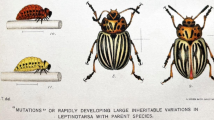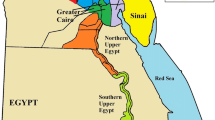Summary
An alternative method of reciprocal recurrent selection (RRS) in which populations A and B are each evaluated in a different environment is proposed. This method is called dual-environment reciprocal recurrent selection (DERRS). Two genetic models are considered in the theoretical study. A comparison of selection methods shows that genetic gain is larger in DERRS than in RRS for the two models. The difference grows greater as the dominance effects operating in the two environments are more divergent and as the number of selection cycles increases. A greater gain is obtained when the genetic covariances between crosses in the two chosen environments are lower.
Similar content being viewed by others
References
Comstock RE, Robinson HF, Harvey PH (1949) A breeding procedure designed to make maximum use of both general and specific combining ability. Agron J 41:360–367
Comstock RE, Moll RH (1963) Genotype x environment interactions. In: Robinson HF, Hanson WD (eds) Statistical genetics and plant breeding. NAS-NCR Publication 982
Cross HZ, Hammond JJ (1982) Plant density effects on combining abilities of early maize synthetics. Crop Sci 22:814–817
Eberhart SA, Russell WA (1966) Stability parameters for comparing varieties. Crop Sci 6:36–40
Falconer DS (1981) An introduction to quantitative genetics. Longman, London New York
Hill RR Jr, Baylor JE (1983) Genotype x environment interaction analysis in alfalfa. Crop Sci 23:811–815
Moreno-González J, Grossman M (1976) Theoretical modifications of reciprocal recurrent selection. Genetics 84:95–111
Moreno-González J, Hallauer AR (1982) Combined S2 and crossbred family selection in full-sib reciprocal recurrent selection. Theor Appl Genet 61:353–358
Ordas A, Stucker RE (1977) Effect of planting density on correlations among yield and its components in two corn populations. Crop Sci 17:926–929
Sprague GF, Federer WT (1951) A comparison of variance components in corn yield trials. 2. Error, year x variety, location x variety and variety components. Agron J 43:535–541
Stuber CW, Moll RH (1977) Genetic variances and hybrid predictions of maize at two plant densities. Crop Sci 23:863–867
Troyer AF, Rosenbrook RW (1983) Utility of higher plant densities for corn performance testing. Crop Sci 23:863–867
Author information
Authors and Affiliations
Additional information
Communicated by A. R. Hallauer
Rights and permissions
About this article
Cite this article
Moreno-González, J. Choice of environments in reciprocal recurrent selection programs. Theoret. Appl. Genetics 71, 652–656 (1986). https://doi.org/10.1007/BF00264271
Received:
Accepted:
Issue Date:
DOI: https://doi.org/10.1007/BF00264271




